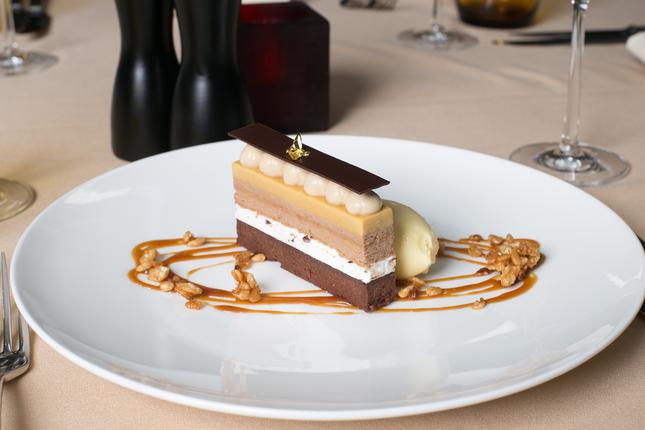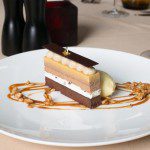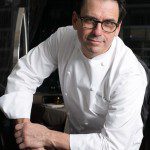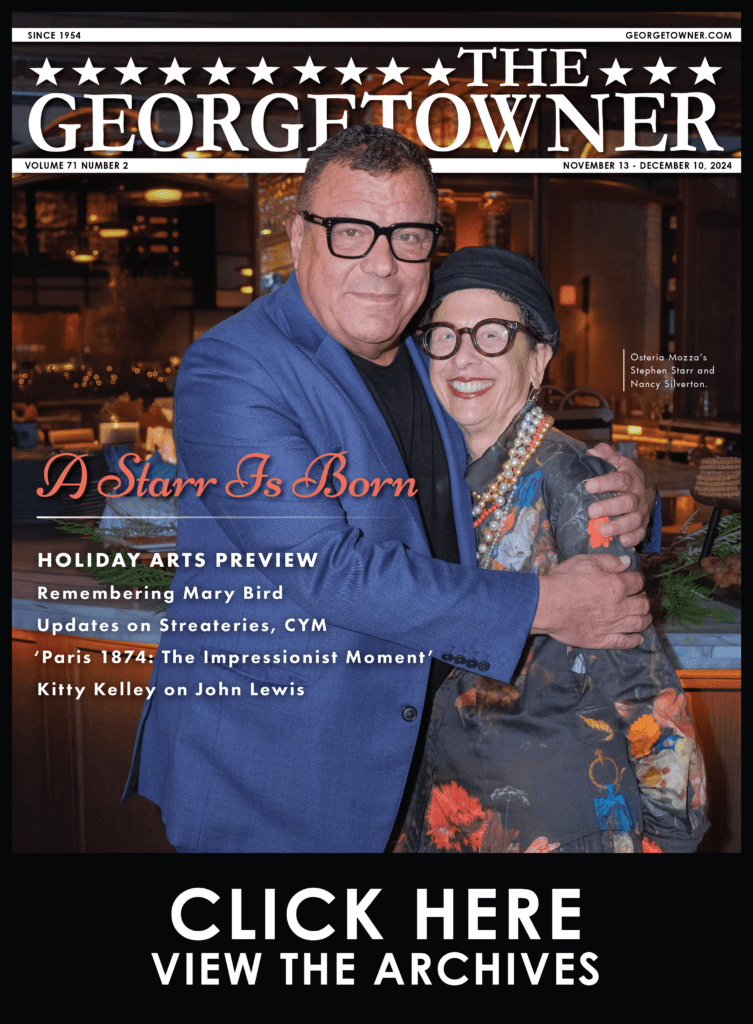In the mid-to-late 20th century, haute cuisine swept Washington, D.C.
Lay the blame on Jacqueline Kennedy, our first lady of cosmopolitan refinement, who so famously brought French culinary traditions to the White House and into vogue (despite her husband, whose tastes were notoriously bourgeoisie américaine).
However, this revolution of the American palate was not without precedent. Washington has a vibrant food history that can be traced from 19th-century taverns—when oysters were cheap and ubiquitous as burgers—through turn-of-the-century tearooms and the supper clubs of Prohibition to opulent midcentury dining rooms like the Willard Hotel, the Occidental Restaurant and the Ebbitt House (now the Old Ebbitt Grill), which modeled themselves on European establishments.
By the 1980s, Georgetown and downtown D.C. were an epicenter of fine dining for the elite. Rive Gauche. La Chaumière. Nathan’s. Citronelle. Jean-Louis at the Watergate. Nathan’s. Sans Souci. Le Pavillon. Le Lion d’Or. These are just a handful of the restaurants – most are gone now — whose Old World elegance and deep-buttoned leather booths welcomed clientele from across the city seeking refinement, comfort and luxury.
Then a gradual but momentous series of events started a culinary revolution. Catalyzed by the information glut of the internet, a combination of health and ingredient consciousness, environmental awareness and a globalized multiculturalism created a new era of more passionate, knowledgeable consumers. Today, we call each other foodies: the many among us who seek new food experiences as destinations, to enrich our senses, bolster our health and broaden our horizons.
Consider free-range meat or poultry, grains like quinoa, Greek yogurt and almond milk, microgreens and whole wheat everything. Twenty years ago, these specialty items were rarely available in restaurants or grocery stores. Now they occupy menus and kitchens across the country.
This seismic epicurean awakening shook the traditional standard of fine dining at its foundation. French and Italian bistros fell to the wayside as gastronomy, concept restaurants, Asian fusion and exotic international cuisine begat a new restaurant boom. As Washington Post food critic Tom Sietsema declared in reference to the closing of the Dining Room at Palena, the lauded Cleveland Park institution, and City Zen in the Mandarin Oriental: “Fine dining was dealt a blow in Washington last year.”
Diners, it seemed, were decidedly focused on new adventures in food.
Mind you, a great deal of good has come out of this trend. It is in many ways a reflection of society itself, and Washington’s culinary evolution is a reflection of what is happening throughout the country. With greater appreciation of food’s cultural significance, chefs today are recognized as creative, intelligent artisans, at once guides to our heritage and defining voices of our future. Cooking is a popular and respected profession for the first time in history, which allows chefs greater opportunities to flourish and to open restaurants that can be singular products of their identity.
In Washington, restaurants like Komi, Little Serow and Rose’s Luxury have attracted national and international acclaim for their innovation and unique culinary perspectives. Komi’s Johnny Monis took Best Chef Mid-Atlantic at the James Beard Awards in 2013. Little Serow was named number seven in the 10 top new restaurants in America by Bon Appétit in 2012. Rose’s Luxury got first place on Bon Appétit’s list of Best New Restaurants in America 2014.
But around the city today, a small, wickedly impressive group of chefs are reviving traditional European standards, combining fresh ideas with the complexity, history and craft of our city’s culinary forebears.
Cementing this revival is none other than Frank Ruta, former chef and owner of Palena, who took over the Grill Room at Georgetown’s Capella hotel on Jan. 2.
Ruta is something of a local legend—the kind of guy you overhear other cooks talk about. Working in a kitchen downtown, I once posed the question to my chef: “Who’s the best chef in the city?” Without a moment’s pause, his eyes and knife still fixed to a half-filleted fish, he said, “Frank Ruta. Get back to work.”
Even as an isolated event, Ruta’s arrival in Georgetown is enough to portend a minor deluge of culinary talent to the neighborhood. But with other likeminded restaurateurs already down the block—including chef Brendan L’Etoile’s Chez Billy Sud, chef Fabio Trabocchi’s Fiola Mare, and Robert Wiedmaier’s newly renovated Marcel’s—it doesn’t seem a far cry to declare Georgetown the heart of a new era of fine dining.
A master of his craft with an exhaustive knowledge of technique, and a tireless cook who oversees every plate that hits the table and makes nearly every food item in house (from the dinner rolls to the mayonnaise), Ruta has made a name for himself as a chef truly synonymous with his kitchen. He also has a reputation for letting his food do the talking—he’s far from hermetic but he keeps a low profile, often deflecting the self-promotion that has developed around the popularization of career cooking.
For me it was always about the food, not the individual…There are so many of us who contribute to a finished plate. I may have been the impetus, but it took everyone, from the front of the house to the prep cooks, to make it happen.
This philosophy is a hard-earned lesson from his professional roots rather than an inherent disdain of publicity. “When I started out around the late ’70s,” he says, “cooks were categorized by the government as laborers, not as professionals.”
Ruta grew up in McKeesport, Pa., a steel-mill town of Polish, Hungarian and Italian immigrants. “My family cooked a lot, but not any more than anybody else in town,” he says. “We had a plum tree, we made a lot of our own sausages, wine. And Sunday dinner was a big deal—as it is with Italians. It was all just part of growing up. But when it came to cooking, it’s just something I loved to do.”
At 16, he started working for a local catering company, and after a brief stint at a nearby restaurant accepted a three-year apprenticeship with the American Culinary Federation.
Ruta chalks up his early career to no more than standard operating procedure. But someone must have noticed him, because at age 21, almost immediately after completing his apprenticeship, he was tapped by first lady Rosalynn Carter to cook in the White House.
He spent the next decade working under legendary White House chefs Henry Haller and Hans Raffert. “These guys were walking encyclopedias of classical cooking,” he says, “and it was instilled within them to pass that knowledge on—they really went out of their way to teach me. And I still think about the things Hans or Haller showed me, or some time that [pastry chef] Roland Mesnier scolded me for screwing something up. They also taught me why you make a dish a certain way, they wouldn’t just say ‘do it.’ Everything was done for a reason. Everything had precedent.”
Working alongside this small group of chefs, as well as maitre d’s and domestic help from the days of Truman and Eisenhower, Ruta learned to be a chef who exists purely and entirely in the arena of the kitchen.
“We didn’t have a mentality that we were out front. You didn’t go starting conversations with the president. And you didn’t talk about it outside of work, either. You just said you were a cook, and back then people would usually leave it at that. Things are a little different today.”
Ruta left the White House in 1987 for Merano, Italy, to work for restaurateur Andreas Hellrigl at Ristorante Andreas. “I wanted to work at an elevated restaurant,” he says (meaning somewhere with a Michelin star). “Just to see what it was like. Back then, all you could do is read about places like that in travel books.”
He found, to his surprise, that he was already at that level—thanks to Haller’s and Raffert’s training—and when Haller retired the following year, Ruta returned to the White House to assume the role of sous chef under Raffert.
After three more years in the White House kitchen, he felt an urge to return to restaurants, with a distant eye toward opening his own. He worked a series of appointments in the ensuing years, mostly with chef Yannick Cam (who now runs the wonderful Bistro Provence in Bethesda).
Once Ruta made the decision to open his own restaurant in 1997, the venture took three years to realize. “People think you open a restaurant and that’s it,” he says, “but even if you have serious financial backing, it takes time.”
Palena opened in 2000, in the Cleveland Park space that once housed chef Carole Greenwood’s eponymous restaurant. In his initial review, Sietsema wrote, “Palena should be required eating for anyone who aspires to cook in this city.”
At Palena, Ruta churned out endless dishes of iconic acclaim: seasonal gnocchi, a truffled cheeseburger, as well as unforgettable renditions of classics like bouillabaisse, mushroom consommé and roast chicken (which guests had to order forty minutes in advance—and did). His plaudits culminated in 2007 when he won the James Beard Award for Best Chef: Mid-Atlantic (shared with Vidalia’s RJ Cooper, who now owns Rogue 24 on N Street NW).
None of this seems to have much affected Ruta, who in retrospect remains unfazed, modest and, frankly, very zen about the whole affair. “We were lucky to have a diligent, passionate, hard-working crew,” he explains with a shrug, quick to credit his team. “We were just back there cooking, doing what we love to do.”
Ruta acknowledges that his kitchen ethics—this heightened awareness of a restaurant as a sort of complex, constantly evolving organism—stem from his White House training, which instilled the value of adhering at all times to a strong foundation.
“If I do something, it has to have precedent,” he says. “If I ate it with my grandparents, learned it from classical cooking or from someone that I worked with—I rely on that anchor. It doesn’t mean we can’t create new things, but it has to pertain to the cooking world and to me, so that I have a way to measure its value or success.”
Palena closed rather suddenly last year, due unfortunately to financial challenges in the wake of the restaurant’s 2010 expansion. Ruta then spent about six months crafting weekly prix-fixe dinners with his Palena partner and pastry chef Aggie Chin and master baker Mark Furstenberg at Mark’s (ridiculously amazing) bakery, Bread Furst. The four-course, family style “Bread Feast” menus, collaboratively conceived and billowing with fresh breads, quickly became one of Washington’s most talked-about dining experiences of 2014. While feeling things out with Capella, this is where Ruta focused his creative energy. “If Capella hadn’t come along,” he says, “we would probably still be doing those dinners.”
Since the beginning of January, Ruta has been slowly fixing his own gears into the existing clockwork of the Grill Room and Rye Bar at Capella. The restaurant has remained open through the transition, so he is developing a new menu while running the current kitchen.
“We’re still in formulation,” he says. “Making a menu is like a game of Tetris—it all has to fit. You’re not making a dish just to fill a slot, it has to make sense why we’re doing that. So we’re using the existing menu as a starting point, slowly evolving it while training the team—except for me, Aggie and the sous chef, we kept the existing staff—getting them to work in a way that’s familiar, the very basics. We’re sort of dismantling everything and starting from the ground up. We don’t want to decorate the cake before we bake it.”
However, guests that come in today can already get small tastes of Ruta’s forthcoming menu, like his seasonal gnocchi, a recipe brought over from Palena. This winter, he is serving it with wild rice and sweet potatoes. Some custom terrines and cooked hams are also available, and more meats—“which need a few more months”—are currently curing in the back. For now, just the idea of it seems enough to satisfy him.
“Capella just seemed like it could be a good fit for the style of cooking we like to do—that spot in between luxury and comfort food. There were dozens of opportunities available, but this one just felt right. I’m still learning the neighborhood, though. I just went to Chez Billy and had a good night there—service was great, food was good. I’m excited to try more places.”
“We have good bones here,” he says, glancingly aware of his offhand culinary metaphor. “The space is beautiful, it’s in Georgetown. I still feel like everything’s in front of me, I’m still trying to get it right. But, really, all I’m going to try to do is cook what I know how to cook.”
Coming from any other chef, that statement would be easy to shrug off. Coming from Ruta, it feels more like an affirmation, fortified by centuries of richly flavored heritage and flush with promise for the future.
- Jordan Wright




